Laptop Mag Verdict
With the Motorola Defy XT, Republic Wireless offers unlimited data, voice and texts for just $20 per month, but there's a fair number of kinks in the service.
Pros
- +
Cheapest wireless service available
- +
Unlimited data, calling and texting
- +
Long battery life over Wi-Fi
Cons
- -
Weak performance
- -
No MMS messaging
- -
Old version of Android
- -
Inconsistent Wi-Fi calling
- -
Short 3G battery life
Why you can trust Laptop Mag
Signing up for a wireless data contract with one of the big four carriers is an expensive proposition, costing anywhere from $70 to more than $100 per month for voice and data. Republic Wireless hopes to change that paradigm by offering the cheapest plan in America: $19 per month with unlimited data, voice and texts. To get this bargain, though, you must live with 3G speeds and purchase the $259 Motorola Defy XT, which isn't exactly the most cutting-edge Android device. Find out if the trade-offs are worth the rock-bottom monthly price.
Republic Wireless Service
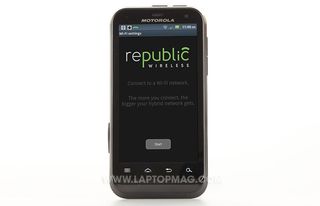
Click to EnlargeFor $19 a month plus a $10 one-time startup fee and the $259 price of the Motorola Defy XT, users get unlimited 3G data, voice and text from Republic Wireless, without signing a contract or paying termination fees when they leave. The carrier says it can offer such an inexpensive plan because it expects users to connect via Wi-Fi from home, the office and other places they frequent. The phone dialer and SMS messaging app are even configured to use Wi-Fi for calls and texts, whenever you're connected to a router.

Click to EnlargeWhen away from a hotspot, the Republic Wireless phone uses Sprint's 3G network to provide coverage anywhere in the U.S. Though Republic Wireless clearly wants you to use Wi-Fi most of the time, it doesn't force you to do so. There's still a Wi-Fi on/off toggle in the settings menu and the company says that it has no data cap or throttling.
When Republic Wireless first announced its service back in fall 2011, the company said that it would cancel the accounts of any user who consistently used too many cellular minutes and too much 3G bandwidth, but after some public pressure, it reversed its position and said that the plan would provide truly unlimited calling and data. However, it's clear that the company would still prefer that you use Wi-Fi most of the time, even if it can't force you to do so.
Call Quality

Click to EnlargeBecause Republic Wireless would like its customers to conserve bandwidth by using Wi-Fi most of the time, the Defy XT supports both Wi-Fi and cellular calling. A Wi-Fi calling icon the shape of a phone handset takes up permanent residence in the status bar and appears as green when you're connected to a hotspot and gray when you're not. No matter how you're connected, you send and receive calls using the standard Android dialer, which displays either "Wi-Fi" or "Cellular" next to the phone number while you're connected.
If you're on a cellular call and enter a Wi-Fi zone, the phone does not switch the call over to Wi-Fi. However, if you are on a Wi-Fi call and walk out of range, the phone hangs up and automatically redials the number. In our testing, this handoff felt rather abrupt and inconvenient. When talking to a co-worker over Wi-Fi, the voice quality got worse as we walked farther away from the router. When we were down to one bar of signal strength, the phone went quiet but it remained unclear whether our connection had just gotten worse or dropped. Several moments later we looked down and saw that the Defy was redialing the number. We would have preferred some notification that our call had dropped and was being redialed.
In our tests, we found the sound quality and reliability far superior on cellular calls. The first several times we tried to make Wi-Fi calls (using two different networks in different locations), audio either cut in and out or disappeared entirely within a minute of connecting. However, when we tried again the next day, we were able to hold a connection and our call partners reported that our voice sounded clear. Nevertheless, voices were not as clear as on cellular, and there was a noticeable delay between when either caller talked and when the other person heard their words.
Cellular calls sounded excellent -- as good as any we've made on Sprint's network. Audio was crystal clear and there was no significant lag between when a user spoke and the sound was broadcast to the other person. Unless and until the Wi-Fi calling improves, we would recommend that users make their calls over cellular via Republic Wireless, even when they're at home.
Text Messaging
The Motorola Defy XT can send and receive SMS messages over Wi-Fi or cellular, but Republic Wireless does not include a dedicated text messaging app. In our testing, SMS messages arrived quickly, but the only way we could initiate a new conversation was to go into the phone dialer and long press on a caller's phone number, then select text messaging.
Republic Wireless does not support MMS messaging, which means that you cannot send or receive photos or videos with your texts. When we sent a photo from another phone to the Defy XT, the message never arrived and did not give either the sender or receiver an error message. Republic Wireless says that MMS is on the company's roadmap.
Design

Click to EnlargeIn a market where smartphones with 4.3-inch screens are now considered compact, the 3.7-inch Motorola Defy XT looks like a 4-foot- tall munchkin trying to compete in the NBA. However, if you want a compact handset, you'll appreciate the Defy's svelte 4.5 x 2.3 x 0.47-inch, 4-ounce body.
The bland-looking Defy XT shares the same aesthetic as its ancient ancestor, the 2010 Motorola Defy, with subtly rounded corners, a dark-gray bezel and a black rubbery back. If you pry the back off, you can upgrade the included 2GB microSD card and replace the 1,650 mAH battery. Unfortunately, the phone has port covers obstructing its headphone and microUSB connectors.
Display and Audio

Click to EnlargeThe Defy XT's 3.7-inch screen provided bright images, but colors looked washed out. At 854 x 480 pixels, the display resolution is acceptable for a budget handset of this size, but weak in comparison to much fancier phones such as the 720p Samsung Galaxy S III or 1080p HTC Droid DNA.
Whether we were looking at the home screen or watching a video, colors appeared muted and dull. When we streamed a YouTube trailer for "The Avengers," colors such as the red in Iron Man's armor or the blue in Captain America's shield looked flat. When we played a 720p MP4 trailer for "SkyFall," tones that had popped on other devices (example: the red and blue in a British flag) were lifeless.
At 351 lux on our light meter, the Defy is close to the smartphone average of 373 lux, the HTC EVO V 4G's mark of 365, and way ahead of the Connect 4G's 225 lux average.
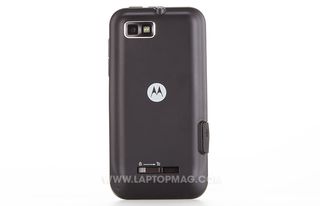
Click to EnlargeThe Defy XT's rear-facing speaker emits sound that's highly accurate and loud enough to fill a room, provided you don't accidentally cover the speaker with your hand, something we did a couple of times. When we played the bass-heavy "Forget Me Nots," sound was accurate though not particularly rich, but Motley Crue's guitar and drum heavy "Shout at the Devil" suffered from noticeable tinniness.
OS and Interface
Navigating through the desktop and menus on the Defy XT is like taking a trip back in time to 2011. While most new Android phones come with at least Android 4.0 Ice Cream Sandwich if not Android 4.1 / 4.2 Jelly Bean, the Defy is saddled with the ancient Android 2.3 Gingerbread OS.
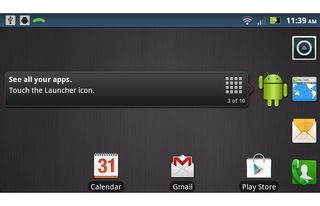
Click to EnlargeThe bottom of the Defy's bezel has old-school navigation buttons for Menu, Home, Back and Search. The device has seven bland home screens to hold your apps and widgets, complete with institutional gray wallpaper. By default, these screens merely have shortcuts for Gmail, the Calendar and the Play store, along with a quick settings widget and a music player widget. A set of four icons--phone dialer, email, browser and apps menu -- sit at the bottom of each home screen. The icons themselves have the ugly Motoblur design we saw on so many of that company's phones, including the Droid 3 and Bionic, back in 2010 and 2011.
In an improvement on stock Android, the notification drawer at the top of the screen shows a horizontally scrollable list of recent apps when you pull it down. The apps menu scrolls vertically and allows you to filter the list by recently used or downloaded apps. Other than that, the Defy XT's implementation of Android 2.3 offers nothing different from Google's stock version.
Keyboards
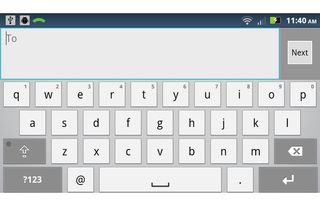
Click to EnlargeThe Motorola Defy XT comes with two virtual keyboards, the stock Android keyboard and Swype, which allows you to form words by tracing between letters. Though the keys on the stock keyboard aren't as large or as attractive as those on Android 4.0 and above, we had no trouble targeting them.
Tracing words in Swype provided highly accurate results; the keyboard correctly recognized by the name "Avram" rather than autocompleting it as "scream" or "Abram" like other trace keyboards have. Best of all, the Droid XT supports haptic feedback, which gives the keys a nice tactile feel as you hit them.
Visually impaired users can take advantage of Eyes Free keyboard, which provides an on-screen D-pad for moving between fields and reads letters as you type them. With Android's built-in accessibility features enabled, Defy XT not only read our input but also read the names of all icons on screen or every word in a text box.
Preloaded Apps

Click to EnlargeIn addition to stock Android apps such as the calculator, camera app, Gmail and Google Play, the phone has a handful of fairly helpful utilities. Battery Manager shows the current battery status and lets you adjust power settings.
Flashlight uses the LED flash to light your way. FM radio allows you to tune into stations. MediaSee lets you browse other media files on your network while MediaSer connects you to other DLNA capable devices for media sharing. Compass shows you a graphical compass that rotates as you turn the phone.
Performance

Click to EnlargeThe Motorla Defy XT is powered by a 1-GHz single-core Qualcomm 7227a CPU, which is good enough for performing basic tasks, but makes navigating through the OS or playing videos feel sluggish. Whether we were unlocking the device, flipping through the home screens, or launching apps, all visual transitions suffered from lag.
While a high-quality YouTube video of "The Avengers" played smoothly, both a 1080p offline trailer for "The Hobbit" and a 720p MP4 trailer for "Skyfall" were as jerky as silent movies. However, we were able to play the Jetskiing game ‘Riptide GP' fairly smoothly.
On Quadrant, a synthetic benchmark that measures overall system performance, the Defy XT scored a mediocre 1,235, well below the 3,478 average, the HTC Evo V 4G's 2,129 mark and the LG Connect 4G's score of 2,307.
The Defy XT provided a similarly weak score on the AN3DBench graphics test, returning a mark of just 6,096. This showing compares unfavorably to the 7,054 category average, the LG Connect 4G's score of 7,404, the HTC Evo V 4G's score of 7,158 and the Kyocera Hydro's mark of 7,380.
3G Speeds
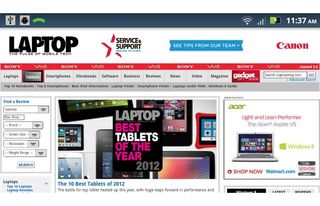
Click to EnlargeWhile Republic Wireless bases its business model on the assumption you'll spend most of your time on Wi-Fi, the carrier provides unlimited 3G service from Sprint's network. When we used Speedtest.net to benchmark the connection from two different Manhattan locations, the Defy XT got solid transfer rates of 1.4 Mbps down and 851 Kbps up. However, in one area on Long Island, we had trouble getting a signal and averaged a meager 120 Kbps down / 435 Kbps up.
In Manhattan, we were able to load Web pages at a reasonable clip over 3G, with Laptopmag.com appearing in 12.3 seconds, the mobile NYTimes.com site in 2.7 seconds and mobile ESPN.com in a modest 8.3 seconds.
Battery Life
Click to EnlargeWhether you're using Wi-Fi or 3G will make a huge difference in your battery life on the Defy XT. When we ran the LAPTOP Battery Test using the Defy XT's 3G connection (continuous Web surfing on 40 percent brightness) , the phone lasted a meager 4 hours and 8 minutes. This runtime is far less than the 5 hour and 51-minute smartphone category average. However, when we ran the same test over Wi-Fi, the phone still had 20 percent of its capacity left when we had to stop it after 9.5 hours of testing.
Camera
Click to EnlargeThe Defy XT's 5-MP rear-facing camera takes mediocre images, with decent color quality but poor sharpness and plenty of noise. When we shot a city street, objects such as parked cars and scaffolding appeared blurry and a pixilated while a car that was rolling slowly looked even worse. An indoor photo of a baby in a playpen suffered from plenty of blur, though the child's red shirt appeared vibrant. Don't whip out the camera and expect a fast shot, as it took more than two seconds to focus and shoot every time we hit the shutter button.
Click to EnlargeThe front-facing VGA camera was much worse, producing a photo of our face that was so blurry and noisy that our facial hair looked like part of our skin.
We wouldn't recommend taking any important videos with the Defy XT, because its rear-facing camera can only capture at 640 x 480 resolution, a far cry from HD. When we shot a video of cars rolling down a city street, colors were true. But just as with the still shots, the edges of objects were blurry and we could see some visual noise.
[sc:video id="g3cXA1cTo3ijW6dhWowBojvzVad-X6C_" width="575" height="398"]
Pricing and Value
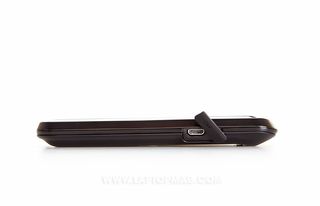
Click to EnlargeThe Motorola Defy XT costs $259 plus a $10 startup fee and $19 per month for service, which adds up to $725 over 24 months.
Virgin Mobile, another low-cost contract-free carrier, charges $35 per month for 2.5GB of 3G/4G WiMax data and messaging but only 300 minutes of talk. Android smartphones cost anywhere from $39.99 for a cheap 3G handset to $329.99 for the popular Samsung Galaxy S II with 4G. If you buy the HTC Evo V 4G for $149, Virgin Mobile will cost you $990 over two years, assuming you opt for its least expensive plan.
Verdict
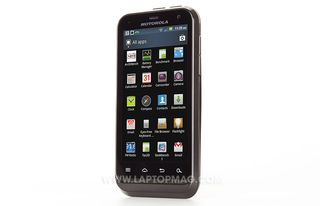
Click to EnlargeThe Motorola Defy XT and the Republic Wireless network that supports it are a classic case of "you get what you pay for." For $19 a month, you get a basic Android phone running on an old-time 3G network that can't send or receive MMS messages. While Republic Wireless' concept is disruptive, the fact that you can't seamlessly transfer from Wi-Fi to 3G and vice versa limits this service's usefulness. We also found the 3G calling quality to be much better than over Wi-Fi. Price-sensitive users who are willing to spend a little more money would be better off purchasing the faster HTC Evo V 4G and a $35-per-month plan from Virgin Mobile. However, if you want the least expensive unlimited plan on the market and are willing to put up with some drawbacks, the Defy XT on Republic Wireless is a workable solution.
Motorola Defy XT Specs
| Brand | Motorola |
| CPU | 1-GHz Qualcomm 7227 (single core) |
| Camera Resolution | 5 MP |
| Carrier | Republic Wireless |
| Company Website | http://www.motorola.com |
| Form Factor | Candybar Touchscreen |
| Front Camera Resolution | 0.3MP |
| GPS | Yes |
| Internal Memory | 2GB |
| Memory Expansion Type | microSDHC |
| Operating System | Android 2.3.7 |
| Ports | microUSB, 3.5mm headphone |
| RAM | 512MB |
| Size | 4.5 x 2.3 x .47 inches |
| Weight | 4 ounces |
| Wi-Fi | 802.11b/g/n |
